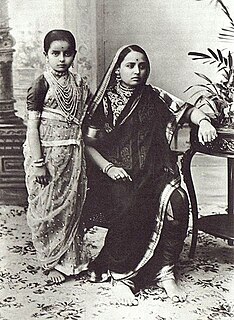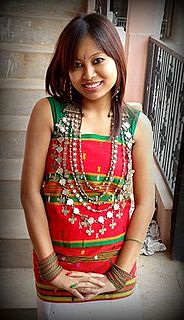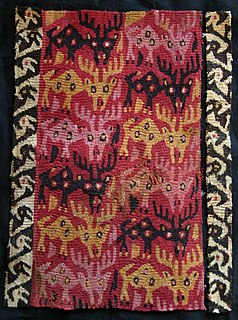
A textile is a flexible material consisting of a network of natural or artificial fibers. Yarn is produced by spinning raw fibres of wool, flax, cotton, hemp, or other materials to produce long strands. Textiles are formed by weaving, knitting, crocheting, knotting or tatting, felting, or braiding.

Weaving is a method of textile production in which two distinct sets of yarns or threads are interlaced at right angles to form a fabric or cloth. Other methods are knitting, crocheting, felting, and braiding or plaiting. The longitudinal threads are called the warp and the lateral threads are the weft or filling. The method in which these threads are inter-woven affects the characteristics of the cloth. Cloth is usually woven on a loom, a device that holds the warp threads in place while filling threads are woven through them. A fabric band which meets this definition of cloth can also be made using other methods, including tablet weaving, back strap loom, or other techniques without looms.

A kerchief, also known as a bandana or bandanna, is a triangular or square piece of cloth tied around the head or neck for protective or decorative purposes. The popularity of head kerchiefs may vary by culture or religion, and may vary among Orthodox Jewish and Christian, Catholic, Amish, and Muslim people.

A sari, saree or shari is a women's garment from the Indian subcontinent that consists of a drape varying from five to nine yards in length and two to four feet in breadth that is typically wrapped around the waist, with one end draped over the shoulder, baring the midriff. There are various styles sari manufacture and draping, the most common being the Nivi style, which originated in Deccan region of India. The sari is worn with fitted bodice commonly called a choli and petticoat called parkar or ul-pavadai. In the modern Indian subcontinent, the sari is considered a cultural icon.
Ikat is a dyeing technique used to pattern textiles that employs resist dyeing on the yarns prior to dyeing and weaving the fabric.

The Barong Tagalog, more commonly known as simply barong, is an embroidered formal shirt and considered the national dress of the Philippines. It is lightweight and worn untucked over an undershirt. The Barong Tagalog was popularized as formal wear by President Ramón Magsaysay, who wore it to most private and state functions, including his own inauguration.

The quechquemitl is a garment which has been worn by certain indigenous ethnicities in Mexico since the pre Hispanic period. It usually consists of two pieces of rectangular cloth, often woven by hand, which is sewn together to form a poncho or shawl like garment, which is usually worn hanging off the shoulders. It can be of various cloths, often with intricate weaves and highly decorated, most often with embroidery. In the pre Hispanic period only women of high social rank could wear it. Since the colonial period, it has been adopted by various peoples, mostly living in central Mexico for everyday wear, festival and rituals, but its use has declined.

Huipil[ˈwipil] is the most common traditional garment worn by indigenous women from central Mexico to Central America.
Maya textiles are the clothing and other textile arts of the Maya peoples, indigenous peoples of the Yucatán Peninsula in Mexico, Guatemala, Honduras, El Salvador and Belize. Women have traditionally created textiles in Maya society, and textiles were a significant form of ancient Maya art and religious beliefs. They were considered a prestige good that would distinguish the commoners from the elite. According to Brumfiel, some of the earliest weaving found in Mesoamerica can date back to around 1000-800 B.C.E.
The manufacture of textiles is one of the oldest of human technologies. To make textiles, the first requirement is a source of fibre from which a yarn can be made, primarily by spinning. The yarn is processed by knitting or weaving, which turns yarn into cloth. The machine used for weaving is the loom. For decoration, the process of colouring yarn or the finished material is dyeing. For more information of the various steps, see textile manufacturing.

Tripuris have their own traditional dresses. This type of dress is similar to that of the rest of the North-East Indian people, but the pattern and design is totally different.

The baro’t saya is the national dress of the Philippines. Barong being its masculine equivalent. Both are all traditionally made of piña though other materials that are not piña are also used in some baro't saya and barong.

Andean textiles represent a continuing textile tradition spanning from the Pre-Columbian era to the Colonial era and present day. Textiles have encompassed a variety of functions, including woven textiles for ceremonial clothing, cloth armour, and record-keeping. Cultural emphasis in the textile arts is often based on the spiritual and metaphysical qualities of the origins of material, as well as cosmological and symbolic messages carried by its visual appearance.

The María Clara gown, sometimes referred to as Filipiniana dress, traje de mestiza or simply terno, is a traditional dress worn by women in the Philippines. It is a form of the Baro't saya. It takes its name from María Clara, the mestiza protagonist of the national epic Noli Me Tangere, penned in 1887 by Filipino national hero José Rizal. It has been connected to the María Clara character because of her traits: delicate, feminine, self-assured and with a sense of identity. The María Clara outfit is the only Philippine national attire that is named after a literary figure. Like all Baro't Saya it is traditionally made out of Piña, the same with the Barong of Men

The Textiles of Mexico have a long history. The making of fibers, cloth and other textile goods has existed in the country since at least 1400 BCE. Fibers used during the pre-Hispanic period included those from the yucca, palm and maguey plants as well as the use of cotton in the hot lowlands of the south. After the Spanish conquest of the Aztec Empire, the Spanish introduced new fibers such as silk and wool as well as the European foot treadle loom. Clothing styles also changed radically. Fabric was produced exclusively in workshops or in the home until the era of Porfirio Díaz, when the mechanization of weaving was introduced, mostly by the French. Today, fabric, clothes and other textiles are both made by craftsmen and in factories. Handcrafted goods include pre-Hispanic clothing such as huipils and sarapes, which are often embroidered. Clothing, rugs and more are made with natural and naturally dyed fibers. Most handcrafts are produced by indigenous people, whose communities are concentrated in the center and south of the country in states such as Mexico State, Oaxaca and Chiapas. The textile industry remains important to the economy of Mexico although it has suffered setback due to competition by cheaper goods produced in countries such as China, India and Vietnam.

Textile arts of indigenous peoples of the Americas are decorative, utilitarian, ceremonial, or conceptual artworks made from plant, animal, or synthetic fibers by native peoples of both North and South America.

Amuzgo textiles are those created by the Amuzgo indigenous people who live in the Mexican states of Guerrero and Oaxaca. The history of this craft extends to the pre-Columbian period, which much preserved, as many Amuzgos, especially in Xochistlahuaca, still wear traditional clothing. However, the introduction of cheap commercial cloth has put the craft in danger as hand woven cloth with elaborate designs cannot compete as material for regular clothing. Since the 20th century, the Amuzgo weavers have mostly made cloth for family use, but they have also been developing specialty markets, such as to collectors and tourists for their product.

Fashion and clothing in the Philippines refers to the way the people of Filipino society dress up in instances such as while they are at home, at work, travelling and when attending special occasions.


















